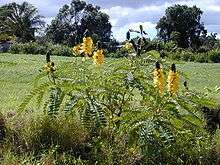Senna didymobotrya
Senna didymobotrya is a species of flowering plant in the legume family known by the common names African senna,[1] popcorn senna, candelabra tree, and peanut butter cassia. It is native to Africa, where it can be found across the continent in several types of habitat.
| Senna didymobotrya | |
|---|---|
 | |
| Scientific classification | |
| Kingdom: | Plantae |
| Clade: | Tracheophytes |
| Clade: | Angiosperms |
| Clade: | Eudicots |
| Clade: | Rosids |
| Order: | Fabales |
| Family: | Fabaceae |
| Genus: | Senna |
| Species: | S. didymobotrya |
| Binomial name | |
| Senna didymobotrya (Fresen.) Irwin & Barneby | |
| Synonyms | |
|
Cassia didymobotrya | |
It has been introduced to many other parts of the world for use as an ornamental plant, a cover crop and a leguminous green manure.[2] In some places it is now naturalized in the wild, for example, in parts of Indonesia, Australia, Mexico, and the United States in California, Florida, and Hawaii.
Description
It is a hairy, aromatic shrub usually growing up to about five meters tall but known to reach nine meters at times.
The leaves are up to half a meter long and are made up of many pairs of elongated oval leaflets each up to 6.5 centimeters long.
The plant has a strong scent which has been variously described as being reminiscent of mice, wet dog, peanut butter, and burnt popcorn.[3]
The plant flowers plentifully in racemes of bright yellow flowers, with some flowers also occurring in leaf axils. The flower raceme has open flowers on the lower part with unopened buds at the tip covered in stark brownish green or black bracts. The flower has five concave petals each 1.5 to nearly 3 centimeters long. The flower has ten stamens, usually seven fertile ones and three sterile staminodes. Some of the stamens have large anthers measuring a centimeter long.
The fruit is a flat brown legume pod up to 12 centimeters long which contains up to 16 bean like seeds up to a centimeter long each.
The plant is poisonous.[4]
Uses
In Kenya, some cultures use it to prepare a special type of sour milk which is used mainly during festivities - being used for this purpose casts doubt on its toxicity.
References
- "Senna didymobotrya". Natural Resources Conservation Service PLANTS Database. USDA. Retrieved 10 November 2015.
- World Agroforestry Centre
- Schmelzer, G. H. and A. Gurib-Fakim. (2008). Plant Resources of Tropical Africa 1: Medicinal Plants. page 507.
- GRIN-link and Blundell, M. 1987. Wild Flowers of East Africa. page 92.
- Collins Mukoyo Sichari "Plants and Cultures in Kenya"
External links
| Wikimedia Commons has media related to Senna didymobotrya. |